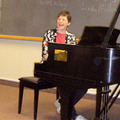Geotag Brooklyn
Trying to track the history of the images of Brooklyn that we’re geotagging for #mapBK on Flickr and Twitter and then porting to Historypin reminds me of the game of tag, with kids dashing from one side of the yard to another.

Eugene Wemlinger. Brooklyn Museum, Prospect Park, Brooklyn, ca. 1903-1910. Brooklyn Museum/Brooklyn Public Library, Brooklyn Collection, 1996.164.10-32.
This huge collection of more than 3500 glass and film negatives has had a pretty peripatetic life, even before its current digital excursions. So, here’s a little of the history behind this 21st century project.
It seems likely that some parts of the collection are the remnants on the late 19th-century collections of the Department of Photography of the Brooklyn Institute of Arts and Sciences, the Museum’s parent organization. George Bradford Brainerd – one of the photographers represented in the glass negative collection — was a member of the Institute’s Photography Department. While the Museum itself didn’t appoint a Photography curator until 1982, we did have a photography studio charged with documenting the art collections as early as 1909. Museum photographer Herman de Wetter, hired in 1934, had curatorial aspirations and began collecting photographs, both historical and contemporary; cataloging the photograph collections already in the Museum; and organizing exhibitions. In 1953, Eye to Eye, the bulletin of the Graphic History Society of America, described nine historical photograph collections at the Brooklyn Museum.
Despite the popularity of the images – they may be seen in many mid-century publications on Brooklyn history – the Museum administration was dubious about committing to photography as part of the art collections. In 1955, shortly after the Director returned the Photography Studio to a service-only mission, the Brooklyn negatives were donated to the Brooklyn Public Library.
Negative collections, especially glass negative collections, are notoriously difficult to store, manage, and provide access to. The negatives are fragile and heavy. Without printing the negatives, it’s very difficult to actually view the images. Photographs are traditionally cataloged at the item level, a time-consuming process. Once BPL’s Brooklyn Collection had printed them (a project they took on in the 1980s), the glass negatives themselves became a burden to preserve.
The Brooklyn Museum’s Photography Curator, Barbara Millstein, still saw them as a treasure, though, and instigated efforts to bring the negatives back under the Museum’s care. In 1996 this was accomplished: the negatives were trucked back up the hill, checked by Conservation staff, rehoused in archival boxes and sleeves, and catalog worksheets created.
The collection, with negatives at the Museum and reference prints at BPL, now has a joint credit line: Brooklyn Museum/Brooklyn Public Library, Brooklyn Collection.
A recent IMLS grant allowed Digital Lab staff to convert the catalog sheets into database records in the Museum’s collections database and make a start at digitizing the images. Nearly 400 images are now on the Museum’s website and on Flickr, with more scanning underway. The beauty of the Digital Age is that it doesn’t really matter where the actual objects reside – they’re as easily accessible in Breukelen (NL) as in Brooklyn.
What now? Crowd sourcing the research needed to expand and correct the titles and place the images on the map. Bringing the data, tags, comments, and corrections full circle, back to the Museum’s collections pages. Members of the Flickr and Twitter community have been pitching in to geotag the images. People are talking, working together, and solving mysteries. Stay tuned! Research a few mysteries yourself!

Deborah Wythe manages the Brooklyn Museum’s Digital Collections and Services department (the “Digital Lab”), coordinating digital imaging activities museum-wide, including the photo studio, scan lab, digital asset management, and rights and reproductions. Before moving to the Digital Lab, Deb was the Museum Archivist, where she managed the Museum’s historical records and worked on several technology-driven projects. Deb edited the new edition of Museum Archives: An Introduction, published by the Society of American Archivists in 2004, and wrote the chapters on the museum context, appraisal, description, records surveys, and photographs. Prior to joining the Brooklyn Museum staff, she worked on the Steinway Collection at the LaGuardia and Wagner Archives and, as an intern, organized the records of the Department of Musical Instruments at the Metropolitan Museum of Art. In her previous life, before discovering archives work (she has always been a museum maven), Deb earned her Master’s and PhD in musicology at NYU. She still studies the piano.



